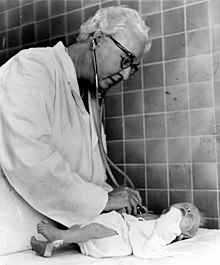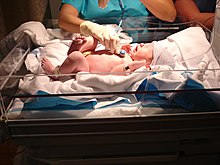Apgar score
The Apgar Score , also known as the Apgar Index , is a point scheme with which the clinical condition of newborns can be assessed in a standardized manner. This assessment, which is carried out one, five and ten minutes after delivery, describes the condition of the newborn and its adaptation to life outside the uterus, i.e. the transition from the fetal to the neonatal condition. The effect of resuscitation measures can also be described. The score was presented in 1952 by the US anesthetist and surgeon Virginia Apgar at the annual meeting of US anesthetists and was later named after her. The first publication took place in 1953, a second report with a larger number of patients was published in 1958.
The five letters of the name Apgar can be used as a memory aid for the five criteria A ppearance , P ulse , G rimace , A ctivity and R espiration of the scoring scheme. A motto in German is: APGAR = A tmung, P uls, G rundtonus, A ussehen, R eflexe. In the sense of this backronym , the notation APGAR-Score is occasionally used.
Medical historical background
Newborns can die as a result of complications during pregnancy or childbirth, i.e. undiagnosed prenatal damage that worsens after birth, or as a result of defects or injuries during labor, such as cerebral haemorrhage , lack of oxygen, or a combination of such damage. Respiratory and circulatory problems can often lead to lifelong consequences or even to the death of the child, although many of them could have been successfully treated if they had been recognized immediately after birth.
Prior to the application of the Apgar score, there was no globally standardized procedure for monitoring and assessing the most important vital signs in newborns. Virginia Apgar wrote in her book Is my Baby All Right? :
"Birth is the most dangerous period of life [...] It is imperative to assess the state of health of newborns quickly and to diagnose any symptoms immediately so that appropriate measures can be taken."
determination
criteria
Five components are assessed to measure the Apgar score:
| Memory aid | criteria | English |
|---|---|---|
| A = breathing | Breathing effort | respiratory effort (respiration) |
| P = pulse | Heart rate | heart rate (pulse) |
| G = basic tone | Muscle tone | muscle tone (activity) |
| A = appearance | Skin color | color (appearance) |
| R = reflexes |
Reflex triggerability (also reflex excitability ) |
reflex irritability (Grimace) |
Measurement and evaluation
The determination is carried out 1 minute, 5 minutes and 10 minutes after the birth . For each characteristic 0 points (characteristic missing), 1 point (characteristic not pronounced) or 2 points (characteristic good) are awarded and entered in the examination protocol; the maximum number of points is 10 per examination unit.
In Germany, the Apgar score is routinely recorded at every birth. (In addition, the umbilical cord pH is determined as an expression of the child's oxygen supply.)
| criteria | 0 points | 1 point | 2 points |
|---|---|---|---|
| Breathing effort | no | irregular, flat | regularly, child screams |
| Heart rate | no heartbeat | below 100 / min | over 100 / min |
| Muscle tone | limp | slight flexion of the extremities | active movement of the extremities |
| Skin color | blue, pale | Trunk rosy, extremities blue | entire body rosy |
| Reflexes | no | Grimacing | vigorous screaming, coughing, sneezing |
The optimal number of points for newborns is 9–10 points, whereby the “missing” point after one minute is usually due to the bluish skin color. A value of 7 or 8 to 10 is said to be “fresh”. With scores between 5–8, the newborn is considered endangered, with scores below 5, it is acutely life-threatening.
According to a standard work of the American Academy of Pediatrics and the American Heart Association on resuscitation of newborns, if Apgar values are below 7, the determination should be repeated twice: 15 and 20 minutes after birth.
Shows the mature newborn, i.e. H. After 37 completed weeks of pregnancy, no abnormalities and if it has adapted well, it stays with the mother in the puerperium or in the newborn's room.
Extended Apgar Score
The ACOG (American College of Obstetricians and Gynecologists), an obstetrics society in the United States, proposed an "extended Apgar score" in 2006. Resuscitation measures up to 20 minutes after the birth can also be documented in the corresponding form. However, the same information is also documented in every resuscitation protocol. In its current statement from 2015, the ACOG reiterates its recommendation to use a form in which Apgar values and resuscitation measures can be entered up to 20 minutes after the birth.
The term "extended Apgar score" is misleading. The ACOG does not propose any changes to the point system, only an addition to the form for documentation. She recommends the integration of a table for entering any necessary resuscitation measures as well as standard space for entering values and measures up to 20 minutes after the birth.
restrictions
The Apgar score describes the physiological and pathophysiological condition of the newborn within a limited period of time. It also contains subjective components.
- The score can be caused by medication, infections, birth trauma , congenital abnormalities, hypovolemia and the like. Ä. to be influenced.
- The child's maturity also affects the Apgar score. Premature babies cannot be adequately assessed with the score, as characteristics such as breathing , muscle tone and reflexes depend on the gestational age . For example, a healthy premature baby with no signs of asphyxia may only get a low Apgar score because it is immature. The frequency of low Apgar scores is inversely proportional to birth weight.
- The score cannot be used to predict neurological complications in punctually born children, although this is repeatedly and incorrectly attempted (see Beller / Holzgreve ). Other factors, such as a suspicious CTG , pathological changes in the umbilical cord blood gas , pathology of the placenta , hematological findings, EEG of the newborn, ultrasound examination and X-ray , neurological dysfunctions and multiple organ failure must therefore be taken into account if hypoxia (i.e. oxygen undersaturation ) during the birth is the cause for cerebral palsy is assumed.
- The score alone is also not sufficient to make a diagnosis of asphyxia . A low Apgar score therefore does not allow a prediction of morbidity and mortality .
- There is a marked difference between an Apgar score obtained during resuscitation and a score obtained from a spontaneously breathing newborn because the components of the score are largely influenced by resuscitation.
Acronyms
- In English the motto is: APGAR = A ppearance (appearance), P ulse (heart rate), G rimace ( grimacing = reflex triggering ), A ctivity (activity = muscle tone), R espiration (breathing). This motto was introduced in 1963 by Joseph Butterfield.
- This corresponds to the German: A ussehen, P ULS, G esichtsbewegungen (or G rimassieren) A ktivität, R espiration (respiration).
Another motto in German is: A tmung, P uls, G rundtonus, A ussehen, R eflexe. Here the criteria are listed in a different order. - In Spanish: A pariencia, P ulso, G esticulación, A ctividad, R espiración.
- In English APGAR was also named A merican P ediatric G ross A ssessment R interpreted ecord, so mutatis mutandis as "American documentation of the overall in pediatrics ."
See also
- Scoring systems
- Petrussa index
- Newborn screening
- Early Disease Detection Program for Newborns
literature
- Virginia Apgar: A proposal for a new method of evaluation of the newborn infant . In: Curr. Res. Anesth. Analg. 32, 1953, pp. 260-267.
- Fritz K. Beller , Wolfgang Holzgreve : The Apgar Score. In: Obstetrics and Gynecology. 107, 2006, pp. 1209-1212. PMID 16648434
- Harald Genzwürker, Jochen Hinkebein: Case book anesthesia, intensive care medicine and emergency medicine. Georg Thieme, Stuttgart / New York 2005, ISBN 3-13-139311-4 , pp. 173-175 ( asphyxia score for newborns according to Virginia Apgar ).
Individual evidence
- ^ Profiles in Science: The Virginia Apgar Papers
- ^ V. Apgar: A proposal for a new method of evaluation of the newborn infant. In: Curr Res Anaesth Analg . tape 32 , 1953, pp. 261-267 .
- ↑ V. Apgar, DA Holaday, LS James, IM Weisbrot: Evaluation of the newborn infant; second report. In: JAMA . tape 168 , 1958, pp. 1985-1988 .
- ^ F. Petermann et al. a .: Developmental Science: Developmental Psychology - Genetics - Neuropsychology. 2004, p. 522: “Test (according to Virginia Apgar) for the diagnosis of the condition of the newborn immediately after birth, in which the breathing movements, the pulse, the basic (muscle) tone, the appearance (skin, face color) and the reflex excitability be assessed."
- ↑ Apgar score in the DocCheck Flexikon
- ↑ www.9monate.de: Apgar Index .
- ↑ American Academy of Pediatrics and American Heart Association: Textbook of Neonatal Resuscitation . 6th edition, 2011. Quoted from ACOG Committee Opinion Number 644 acog.org, October 2015.
- ↑ ACOG Committee Opinion No. 333, May 2006. Translation and commentary: The Apgar Score (PDF), in: Frauenarzt 48 (2007), pp. 759–762.
- ↑ ACOG Committee Opinion No. 644 acog.org, October 2015. With confirmation in 2017.
- ^ Franz Petermann, Kay Niebank, Herbert Scheithauer: Developmental science: developmental psychology, genetics, neuropsychology (= Springer textbook ). 1st edition. Springer, Berlin 2004, ISBN 3-540-44299-5 , 8.2.1 Pre-, peri- and postnatal risk-increasing conditions, p. 328 .

